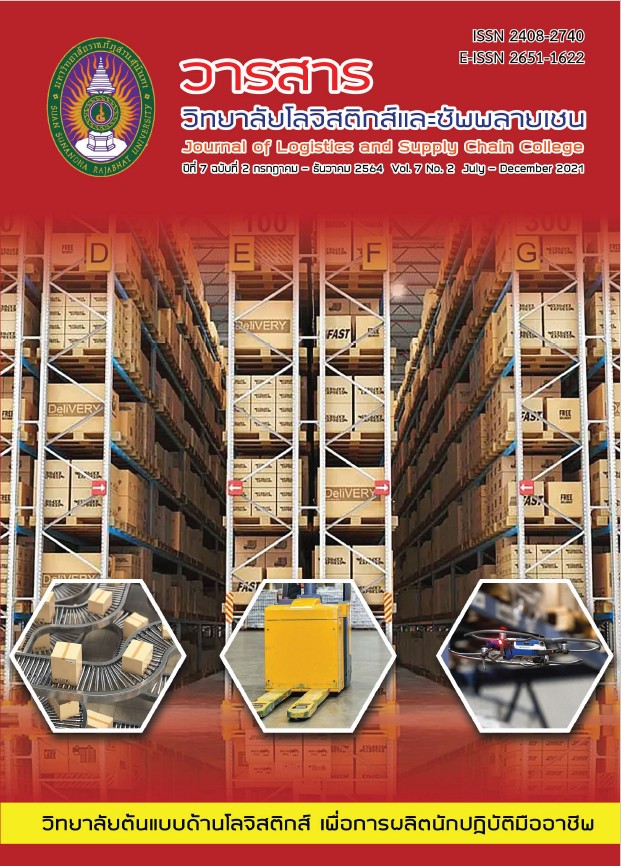The Approaches of Human Resource Development Using Automated Warehouse System to Competitiveness Enhancement and Cost Advantage: A Case Study of Food Processing Business in Samut Sakhon Province.
Keywords:
Human Resource Development, Competitiveness, Cost Advantage, Automated Warehouse SystemsAbstract
This research aimed to 1) study the ability of human resource development with automated warehouse system, and 2) enhance the competitiveness and to reduce the production costs: a case study of Food Processing Business in Samut Sakhon Province. This research is a qualitative research that collected all data from the keymen who were concerned with the automated warehouse system. There were 10 keymen that consisted of 4 system users, 2 system integrators, 2 system constructors and 2 system operators. The instrument of data collection was the focus group discussion with the observation and voice records. The researcher analyzed documents, related researches, and data by considering validity, specifically content validity. The research results revealed these supports could help workers lower the costs, shorten the production time and respond to customers rapidly, and make the organization reduce costs and production time, and increase more customers’ confidence. The customers would ensure about the quality of goods received and the punctuality. Therefore, it showed that the organization that had developed human resources together with an automated warehouse system could enhance the competitiveness as well.
References
จุฑาทิพย์ ลีลาธนาพิพัฒน์ และธีระวัฒน์ จันทึก. (2561). การจัดการสินค้าคงคลังอย่างมืออาชีพ. Veridian E Journal, 1(1), 226-241.
ณัฐวุฒิ วงษ์วรรณ, ณัฎภัทรศญา เศรษฐโชติสมบัติ และณัฐพัชร์ อารีรัชกุลกานต์. (2564). การเพิ่มประสิทธิภาพ การจัดการคลังสินค้าโรงงานทูน่ากระป๋องด้วยระบบคลังสินค้าอัตโนมัติ. วารสารวิทยาลัยโลจิสติกส์และซัพพลายเชน, 7(1), 126-140.
ดีอนันต์ บุญสิมะ. (2557). การบริการการเปลี่ยนแปลงเพื่อสร้างความได้เปรียบทางการแข่งขันของบริษัทในอุตสาหกรรมผลิตเหล็กเส้นไทย. วารสารวิชาการมหาวิทยาลัยกรุงเทพธนบุรี, 2(2), 107-113.
วัชระ วัธนารวี และภูมิพัฒน์ มิ่งมาลัยรักษ์. (2561). การสังเคราะห์องค์ความรู้ในด้านความสามารถในการแข่งขันของธุรกิจการค้าชายแดน จังหวัดเชียงราย. วารสารวิทยาการจัดการ, 14(1), 49-71.
นฤดม เจริญพานิช. (2556). ศึกษาแนวโน้มการเลือกใช้เครื่องจักรอัตโนมัติ กรณีศึกษา บริษัท โตโยต้า มอเตอร์ ประเทศไทย จำกัด. คณะเศรษฐศาสตรมหาบัณฑิต, มหาวิทยาลัยธรรมศาสตร์.
นิภาพรรณ เจนสันติกุล. (2559). กลไกการพัฒนาทรัพยากรมนุษย์เพื่อเพิ่มศักยภาพในการแข่งขันและการเข้าสู่ประชาคมอาเซียนในมหาวิทยาลัยราชภัฏ. วารสารวิชาการมหาวิทยาลัยหอการค้าไทย, 36(1), 196-208.
ปรีดาพร คณทา และดารารัตน์ อินทร์คุ้ม. (2559). ทุนมนุษย์กับการพัฒนาทรัพยากรมนุษย์แนวคิดใหม่. วารสารนวัตกรรมและการจัดการ,1(1), 62-70.
ปัญ์ญจทรัพย์ ปัญญาไว และรวิพรรณ สุภาวรรณ์. (2559). ปัจจัยการยอมรับเทคโนโลยี และประเทศแหล่งกำเนิดสินค้าที่ส่งผลต่อทัศนคติในการใช้บริการ Pre-order เครื่องสำอางผ่านทางออนไลน์ของผู้บริโภคในเขต กรุงเทพมหานคร. วารสารนวัตกรรมและการจัดการ, 1(1), 32-40.
ปราโมทย์ ลือนาม. (2554). แนวความคิด และการวิวัฒนาการของแบบจำลองการยอมรับการใช้เทคโนโลยี.วารสารการจัดการสมัยใหม่, 9(1), 9-16.
พัชราภา สิงห์ธนสาร. (2561). การปฏิบัติการภายใต้การจัดการโซ่อุปทานที่ส่งผลต่อความได้เปรียบในการแข่งขันด้านต้นทุนและความสามารถในการแข่งขันของธุรกิจส่งออกอาหารในประเทศไทย. วารสารมจร สังคมศาสตร์ปริทรรศน์, 7(2), 152-165.
พงศกร ศรีรงค์ทอง. (2561). การพัฒนาทรัพยากรมนุษย์ องค์การแห่งการเรียนรู้ และการจัดการความรู้การบูรณาการแนวคิดเพื่อนำไปสู่ความสำเร็จขององค์การ. วารสารจันทรเกษมสาร, 24(47), 1-16.
ธัญญลักษณ์ วีระสมบัติ. (2562). การใช้ระบบอัตโนมัติและทักษะแรงงานที่จำเป็นสำหรับซัพพลายเออร์ไทยในอุตสาหกรรมยานยนต์. วารสารสังคมสงเคราะห์ศาสตร์, 27(2), 1-26.
วสุธิดา นักเกษม และธีระวัฒน์ จันทึก. (2562). ความสัมพันธ์เชิงสาเหตุของปัจจัยที่ส่งผลต่อการสร้างความได้เปรียบทางการแข่งขันของผู้ประกอบการธุรกิจบริการในเขตกรุงเทพมหานคร. วารสารวิชาการมหาลัยศิลปากร, 12(2), 1075-1097.
ศิริยุพา รุ่งเริงสุข. (2560). แนวโน้มความท้าทายในสายงาน HR ยุคใหม่,. สืบค้นเมื่อ 1 พฤษภาคม 2564 จาก: https://www.dst.co.th/index.php?option=com_content&view=article&id=1364: hr&catid=29&Itemid=180&lang=en
สุชน ทิพย์ทิพากร จิราวรรณ คงคล้าย และเฉลิมชัย กิตติศักดิ์นาวิน. (2560). การบริหารทรัพยากรมนุษย์เพื่อสร้างความสามารถในการแข่งขันของวิสาหกิจขนาดกลางและขนาดย่อม (SMEs). วารสารบัณฑิตศึกษา,11(2), 251-260.
สมคิด ผลนิล และเฉลิมชัย กิตติศักดิ์นาวิน. (2559). การพัฒนาทรัพยากรมนุษย์และบรรยากาศองค์การที่มีผลต่อการทำงานเป็นทีมกรณีศึกษากรมอุทยานแห่งชาติ. วารสารศิลปศาสตร์, 12(2), 109-134.
Anas M. Atieh, Hazem Kaylani, Yousef Al-abdallat, Abeer Qaderi, Luma Ghoul, Lina Jaradat &Iman Hdairis. (2016). Performance improvement of inventory, management system processes by an automated warehouse management system. Procedia CIRP. 568-572.
Battour, M., Barahma, M., & Al-Awlaqi, M. (2021). The Relationship between HRM Strategies and Sustainable Competitive Advantage: Testing the Mediating Role of Strategic Agility. Sustainability, 13(9), 5315.
Bozer, Y. A., & White, J.A. (1984). Travel-time models for automated storage/retrieval systems. IEE Transactions.
Davis, F., Bagozzi, R., & Warshaw, P. (1989). User Acceptance of Computer Technology: a Comparison of Two Theoretical Models. Management Science, 982-1003.
Donald S. Siegel, David A. Waldman, & William E. Youngdahl. (1997). The Adoption of Advanced Manufacturing Technologies: Human Resource Management Implications. IEEE Transactions on Engineering Management, 44(3), 288-298.
Douglas, M.L., (1975). The Development of Inventory Costing Methodology: A Study of the CostAssociated with Holding Inventory. Chicago: NationalCouncil of Physical.
Fabrizio Dallari, Gino Marchet & Remigio Ruggeri. (2015). Optimisation of man-on-board automated storage/retrieval systems. Integrated Manufacring System, 11(2), 87-93.
Fukitkan, C. (2013). The Process of Strategic Human Recourse Development. Journal of Humanities and Social Sciences, 4(1), 33-45.
Hanan, M., Kharia, A., & Abdulmuttalib, T. (2019). The Automatic Storage and Retrieval System: An Overview. International Journal of Computer Applications, 177, 36-43.
Jenbunjerd. (2020). กฎเหล็ก 5 ข้อที่ควรรู้เพื่อประโยชน์จากการลงทุนในระบบคลังสินค้าอัตโนมัติ,. สืบค้นเมื่อ 23 มิถุนายน 2564 จาก: https://www.jenbunjerd.com/blog/5-กฎเหล็ก-ก่อนการลงทุนในระบบคลังสินค้าอัตโนมัติ-46.html
Kamila Kluska (2021). Automatic simulation modelling of warehouses. Logforum 17(1), 5. DOI: 10.17270/J.LOG.2021.547
Kulwiec, R. (2007). RELIABILITY OF AUTOMATED STORAGE AND RETRIEVAL SYSTEMS ( AS / RS ) A WHITE.
Lewczuk, K., Kłodawski, M., & Gepner, P. (2021). Energy Consumption in a Distributional Warehouse: A Practical Case Study for Different Warehouse Technologies. Energies, 14(9), 2709. MDPI AG. Retrieved from http://dx.doi.org/10.3390/en14092709.
Lee H.F., & Schaefer S.K. (1996). Retrieval sequencing for unit-load automated storage and retrival system with multiple openings. International Journal of Production research, 34(10), 2943-2962.
Marquardt M.J. (1999). Action learning in action: Transforming problems and propel for world-class organization learning. Palo Alto: Davies-Black.
McClelland, D.C., (1975). A Competency model for human resource management specialists to Be used in the delivery of the human resource management cycle. Boston: Mcber.
Nadler, L. & Wiggs, G.D. (1989). Managing human resources development. San Francisco, California: Jossey-Bass.
Ramaa,A.,K.N. Subramanya, & T. M. Rangaswamy. (2012). Impact of Warehouse Management System in a Supply Chain. International Journal of Computer Applications, 54(1), 14–20.
Velikorosov, V. V., Filin, S. A., Genkin, E. V., Maksimov, M. I., Krasilnikova, M. A. & Rakauskiyene, O.G.. (2020). HR Systems as a New Method for the Automatization of Business Processes in Organization. 2020 The 2nd International Conference on Pedagogy, Communication and Sociology, 415-418.



